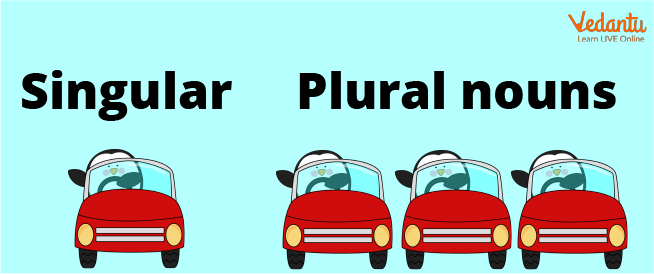Essential Rules and Practice Questions for Class 2 Singular and Plural
FAQs on CBSE Class 2 English Grammar: Singular and Plural Made Easy
1. What types of important questions on Singular and Plural nouns are usually asked in Class 2 exams?
For Class 2 English exams, you can expect a few common types of questions on this topic. These often include:
- Fill in the blanks: You might see a sentence like "I have one cat, but my friend has two ____."
- Change the word: You will be given a singular noun like 'book' and asked to write its plural form, 'books'.
- Choose the correct word: You may have to pick the right option in a sentence, for example, "There are many (tree/trees) in the park."
- Picture questions: You might be shown a picture with multiple items and asked to write the correct plural noun.
Practising these formats will help you prepare well for your exam.
2. How can I get full marks in questions about changing a singular noun to its plural form?
To score full marks, remember the basic rules. For most words, you just add an -s (like dog → dogs). For words ending in s, sh, ch, x, or z, you add -es (like box → boxes). For words ending in 'y', you often change the 'y' to -ies (like baby → babies). Also, memorise the special plurals that don't follow any rule, like man → men and child → children.
3. Where can I find important questions for Class 2 Singular and Plural for the 2025-26 exams?
You are in the right place! This page contains a curated list of important questions for Class 2 Singular and Plural, designed by subject experts. These questions cover all the key rules and tricky words that are frequently asked in exams, helping you practise and prepare according to the latest CBSE syllabus for 2025-26.
4. Why do some plural words end in ‘es’ (like buses) while most just end in ‘s’ (like cars)?
This happens because of how the word sounds. It's hard to say the plural of 'bus' by just adding an 's' (buss). Adding -es makes it easier to pronounce (bus-ez). This rule is generally for words that end with sounds like s, sh, ch, x, or z. It helps make the plural form clear and easy to say.
5. Are there any tricky words that are the same for both singular and plural?
Yes, some words don't change at all, and these are often asked as tricky questions in exams! For example, one sheep and many sheep, or one fish and many fish. It's a good idea to remember these special words as they are an important part of this chapter.
6. How do I know when to change 'y' to 'ies' for plural nouns?
Here's a simple trick that is very important for exams. Look at the letter just before the 'y'.
- If the letter before 'y' is a consonant (like b, d, r, p), you change the y to -ies. For example, in 'puppy', 'p' is a consonant, so it becomes 'puppies'.
- If the letter before 'y' is a vowel (a, e, i, o, u), you just add -s. For example, in 'boy', 'o' is a vowel, so it becomes 'boys'.
7. Why is it important to learn the correct singular and plural forms for my exams?
Using the correct singular and plural forms is very important for making proper sentences. In your exams, questions on this topic check if you can use grammar correctly. Getting it right shows you have a good understanding of English and helps you score higher marks not just in grammar exercises, but also in sentence-making and creative writing questions.



















